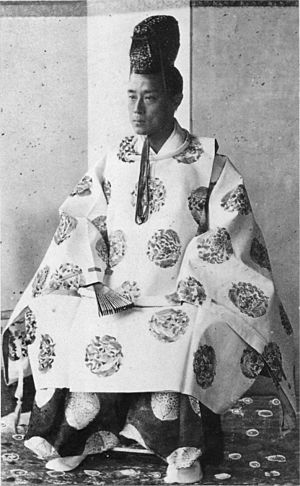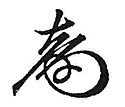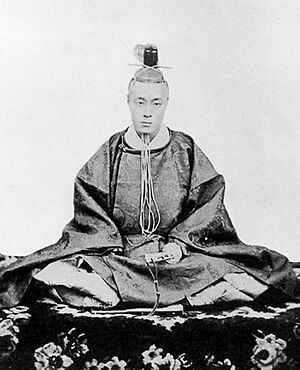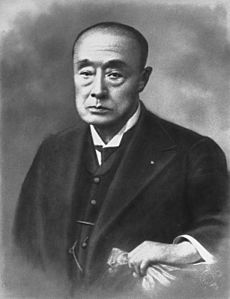Tokugawa Yoshinobu facts for kids
Quick facts for kids PrinceTokugawa Yoshinobu 徳川 慶喜 |
|||||
|---|---|---|---|---|---|

Yoshinobu in 1867
|
|||||
| Shōgun | |||||
| In office | August 29, 1866 — 3 January 1868 | ||||
| Predecessor | Tokugawa Iemochi | ||||
| Successor | Position abolished Itō Hirobumi (as Prime Minister of Japan) |
||||
| Monarch | |||||
| Member of the House of Peers | |||||
| In office | 1902–1910 | ||||
| Born | October 28, 1837 Edo, Japan |
||||
| Died | November 22, 1913 (aged 76) Bunkyō, Japan |
||||
| Burial | Yanaka Cemetery | ||||
| Spouse | Ichijo Mikako | ||||
| Father | Tokugawa Nariaki | ||||
| Mother | Arisugawa Yoshiko | ||||
| Signature |  |
||||
| Japanese name | |||||
| Kanji | 徳川 慶喜 | ||||
| Hiragana | とくがわ よしのぶ | ||||
| Katakana | トクガワ ヨシノブ | ||||
|
|||||
Prince Tokugawa Yoshinobu (徳川 慶喜, also known as Keiki; October 28, 1837 – November 22, 1913) was the 15th and last shōgun of the Tokugawa shogunate of Japan. A shōgun was a military ruler who governed Japan for hundreds of years. Yoshinobu tried to make the shogunate stronger, but he was not successful. He gave up his role as shogun in late 1867. After a defeat in early 1868, he decided to live a quiet life away from the public.
Contents
Becoming a Leader: Yoshinobu's Early Life
Tokugawa Yoshinobu was born in Edo (now Tokyo) in 1837. He was the seventh son of Tokugawa Nariaki, a powerful lord called a daimyō from Mito. Mito was one of the three special families related to the Tokugawa clan. These families could provide a new shōgun.
Yoshinobu's birth name was Matsudaira Shichirōmaro. His mother was Princess Arisugawa Yoshiko. She was from a branch of the imperial family. This meant Yoshinobu was related to the Emperor.
He grew up with strict training in reading, writing, and martial arts. He also learned a lot about politics and how to govern. When he was seven months old, he moved to Mito. He studied at a famous school called Kōdōkan.
To give him a better chance to become shōgun, Yoshinobu was adopted into the Hitotsubashi-Tokugawa family. He became the head of this family in 1847 and changed his name to Yoshinobu.
When the 13th shōgun died in 1858, Yoshinobu was a possible replacement. His supporters praised his skills. However, another group chose a younger candidate, Tokugawa Yoshitomi. He became the 14th shōgun, Iemochi. Yoshinobu and his supporters were then put under house arrest, meaning they had to stay at home.
After a leader named Ii Naosuke was killed in 1860, Yoshinobu was allowed to return. In 1862, he became the shōgun's guardian (将軍後見職, shōgun kōken-shoku). This meant he helped guide the young shōgun. His friends, Matsudaira Yoshinaga and Matsudaira Katamori, also got important jobs. They worked to calm political problems in Kyoto. They also tried to stop rebellious groups like the Chōshū Domain. These leaders wanted to bring the shogunate and the Emperor's court closer together.
In 1864, Yoshinobu led forces to protect the imperial palace. He defeated the Chōshū forces at the Hamaguri Gate (蛤御門, Hamaguri-Gomon). This event is known as the Kinmon Incident.
Becoming Shogun: Japan's Last Military Ruler
After the 14th shōgun, Tokugawa Iemochi, died in 1866, Yoshinobu was chosen to be the 15th shōgun. He was the only Tokugawa shōgun who never lived in Edo Castle during his time as ruler.
As soon as Yoshinobu became shōgun, he started making big changes. He wanted to make the Tokugawa government stronger. He got help from other countries. For example, the Second French Empire helped build the Yokosuka arsenal. They also sent a French military mission to train Japan's army.
The national army and navy also got stronger with help from Russia and Britain. Japan also bought equipment from the United States. Many people thought the Tokugawa Shogunate was becoming powerful again. But it ended in less than a year.
The Boshin War: A Time of Change
Some powerful samurai from Satsuma, Chōshū, and Tosa worried about the shogunate getting too strong. They formed an alliance against it. They used the slogan sonnō jōi ("revere the Emperor, expel the barbarians!"). They also feared Yoshinobu would become as powerful as the first shōgun, Tokugawa Ieyasu.
The Tosa group suggested a peaceful solution. They wanted Yoshinobu to step down as shōgun. Then, he could lead a new council of powerful lords. On November 9, 1867, Yoshinobu officially resigned and gave his power back to the Emperor. He then moved from Kyoto to Osaka.
However, the Satsuma and Chōshū groups did not want Yoshinobu to lead the new council. They secretly got an order from the Emperor to use force against Yoshinobu. They moved many troops into Kyoto. Yoshinobu was stripped of his titles and land, even though he had done nothing wrong. Yoshinobu protested this unfair action. He sent his troops to deliver a message to the imperial court.
When Tokugawa forces reached Kyoto, they were attacked by Satsuma and Chōshū troops. This started the Battle of Toba–Fushimi, the first battle of the Boshin War. Even though Yoshinobu's army had more soldiers, he left them during the fight. He escaped to Edo when he saw the enemy raise the Emperor's banner. He then surrendered to the imperial court.
A peace agreement was made. Tayasu Kamenosuke, a young relative, became the new head of the Tokugawa family. On April 11, Edo Castle was given to the imperial army. This saved the city from a full-scale war.
Yoshinobu moved to Shizuoka with Kamenosuke. Centuries earlier, Tokugawa Ieyasu, the founder of the shogunate, had also retired to Shizuoka. Many of Yoshinobu's former followers also moved to Shizuoka. Some of them struggled to find work and were angry at Yoshinobu. He was so worried about being attacked that he changed his sleeping place often.
Life After Power: Yoshinobu's Quiet Years
Yoshinobu lived a quiet life after his retirement. He enjoyed many hobbies, such as oil painting, Kyudo (Japanese archery), hunting, photography, and cycling. Some of his photographs have been published by his great-grandson, Yoshitomo.
In 1902, Emperor Meiji honored Yoshinobu for his service to Japan. He was allowed to start his own branch of the Tokugawa family. He was given the highest rank, that of a prince (kōshaku). He also became a member of the House of Peers, a special council. He resigned from this position in 1910. Tokugawa Yoshinobu passed away on November 21, 1913, and is buried in Yanaka Cemetery, Tokyo.
His ninth daughter, Tsuneko Tokugawa (1882–1939), married Prince Fushimi Hiroyasu in 1896. His granddaughter, Kikuko Tokugawa, born in 1911, married Prince Takamatsu, the brother of Emperor Shōwa.
Honors and Recognition
- Prince (June 3, 1902)
- Grand Cordon of the Order of the Rising Sun (April 30, 1908)
- Grand Cordon of the Order of the Rising Sun with Paulownia Flowers (November 22, 1913; given after his death)
Family Life
- Father: Tokugawa Nariaki
- Mother: Arisugawa Yoshiko (1804–1893)
- Wife: Ichijo Mikako (1835–1894)
- Concubines: Isshiki Suga, Shinmura Nobu, Nakane Sachi, Oyoshi
- Children: Yoshinobu had many children. Some of them include:
- Sumiko (1863-1927) by Mikako
- Tokugawa Kyoko (1873–1893) by Nobu
- Tokugawa Atsushi (1874–1930) by Sachi
- Tokugawa Tetsuko (1875–1921) by Nobu
- Hachisuka Fudeko (1876–1907) by Sachi
- Ikeda Nakahiro (1877–1948) by Nobu
- Namiko (1880–1954) by Sachi
- Kuniko (1882–1942) by Sachi
- Tokugawa Tsuneko (1882–1939) by Nobu
- Itoko (1883–1953) by Sachi
- Tokugawa Yoshihisa (1884–1922) by Nobu
- Tokugawa Eiko (1887–1924) by Nobu
- Tokugawa Makoto (1887–1968) by Nobu
- Katsu Kuwashi (1888–1932) by Nobu
- Adopted Son: Tokugawa Iesato (1863-1940), who became the 16th head of the Tokugawa Clan.
Yoshinobu's grandson, Tokugawa Hiromi, joined the Imperial Japanese Navy. He was killed in action during World War II in 1943.
See also
 In Spanish: Tokugawa Yoshinobu para niños
In Spanish: Tokugawa Yoshinobu para niños
- Bakumatsu
- Meiji Restoration
- Tokugawa Yoshinobu-ke





